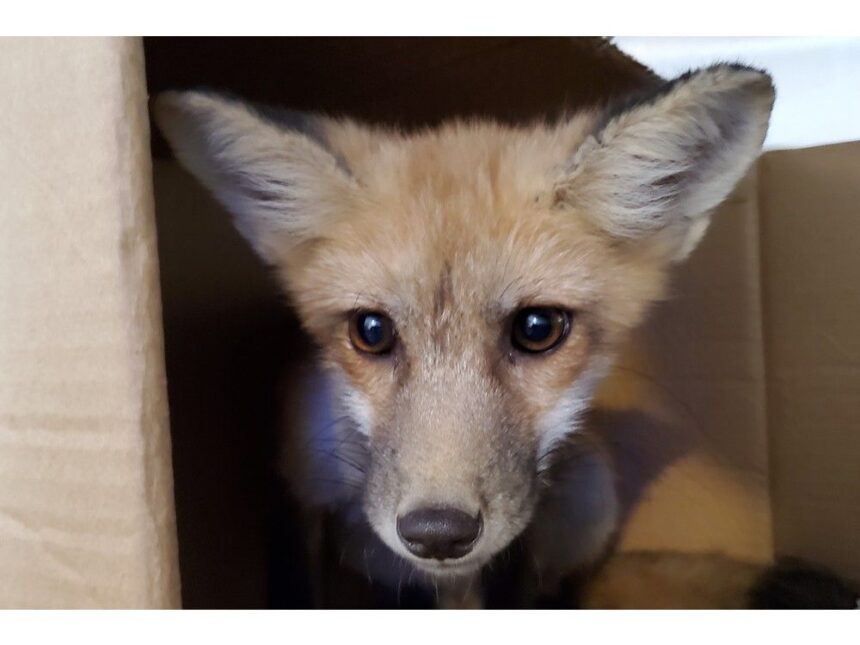Imagine how great mum feels when she’s able to finally step outside the den and grab a well-deserved moment for herselfAuthor of the article: Brenda Boates – Nova Scotia Wild, PNI Atlantic Published Apr 30, 2025 • Last updated 2 hours ago • 2 minute readAn orphaned fox kit that was taken to the Cobequid Wildlife Rehabilitation Centre. Photo by Brenda BoatesIn the spring, two seasonal fox events happen: Dog foxes (male foxes) and vixens (females) shed (boy, do they!), and as well, cubs are born. When foxes shed, they look to be in an awful way: They are patchy, dull coated, scraggly, and very thin (a result of using up their fat reserves throughout the winter). To concerned onlookers, they look sick. A group of orphaned fox kits at the Cobequid Wildlife Rehabilitation Centre. Photo by Brenda BoatesThe vixens in particular look even more frazzled as they are nursing their babies and burning even more calories for milk production.THIS CONTENT IS RESERVED FOR SUBSCRIBERS ONLY.Subscribe now to access this story and more:Unlimited access to the website and appExclusive access to premium content, newsletters and podcastsFull access to the e-Edition app, an electronic replica of the print edition that you can share, download and comment onEnjoy insights and behind-the-scenes analysis from our award-winning journalistsSupport local journalists and the next generation of journalistsSUBSCRIBE TO UNLOCK MORE ARTICLES.Subscribe or sign in to your account to continue your reading experience.Unlimited access to the website and appExclusive access to premium content, newsletters and podcastsFull access to the e-Edition app, an electronic replica of the print edition that you can share, download and comment onEnjoy insights and behind-the-scenes analysis from our award-winning journalistsSupport local journalists and the next generation of journalistsRegister to unlock more articles.Create an account or sign in to continue your reading experience.Access additional stories every monthShare your thoughts and join the conversation in our commenting communityGet email updates from your favourite authorsSign In or Create an AccountorArticle contentWhile the vixen is den-bound with nursing, grooming, and cleaning her babies, the dog fox feeds and protects her and their cubs. The babies nurse for four to six weeks. Cubs start to test and eat solid regurgitated foods from mum at around 3.5 weeks. Foxes are excellent parents, both hunt to feed their fast-growing and oh so hungry, very demanding babies. For the first two or three days, the vixen will not usually leave her babies, not even for a drink. Imagine how great mum feels when she’s able to finally step outside the den and grab a well-deserved moment for herself. A vixen with her kits in the wild. Photo by Ron HowellIt’s a full-time job feeding, warming, grooming, cleaning, and protecting babies. Add stress and exhaustion, viola — more springtime frazzles, and, wow, vixens can look poorly. Article contentSOME FUN FOX FACTSWhile males are called dog(s) or dog fox, and females are called vixen, baby foxes can be called cubs, kits or kites.Foxes often choose and prefer to den near humans. They have learned that human activity tends to ward off their cubs’ natural predators. It takes one month before cubs can thermoregulate their own body temperatures, relying upon mum 100 per cent to stay warm till then. A fox kit is weighed at the Cobequid Wildlife Rehabilitation Centre. Photo by Brenda BoatesFoxes can eat up to a thousand voles throughout the winter.Foxes on average will eat up to 2.5 lbs of food a day. A large portion of this would be rodents and other perceived pests. They are a gardener’s true friend.Foxes are solitary hunters. They do not hunt in packs.In Nova Scotia, our native fox is the red fox, reaching a weight of up to 15 lbs. with an average weight is 11 lbs. Red fox cubs are born with black woolly baby fur and blue eyes. By the end of May, cubs are usually fully weaned and their colour changes to red fox splendour. The adults have shed out, and their beautiful, lush fur coats and floofy tails regain their rich, glossy glory.HOW YOU CAN HELPA final few words on how to help our beautiful fox friends thrive and survive. A fox kit cared for by staff at the Cobequid Wildlife Rehabilitation Centre. Brenda Boates Photo by Brenda BoatesWhen well-meaning humans start feeding foxes processed foods (this includes pet foods as well as grocery items), two things happen: Declining body condition, malnourishment including a diminished immune system. Changes in natural hunting behaviours and survival skills.Help save and keep the wild in our wildlife by leaving the wildlife to feed and raise themselves naturally.Article content
NOVA SCOTIA WILD: Springtime foxy frazzles of vixens, dog foxes, kits, cubs, and kites











